|
|
|
|
|
|
|
Welcome to SPEEDSTER!
| |
In National Event News...
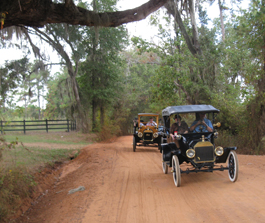 The Glidden Tour for 2013 has had a venue change. The tour will not be in Vermont but is now slated for Chattanooga, TN. This tour promises to be an exceptional event even with the last minute change as the Chickamauga Region and Staff at Coker Tire are working feverishly to produce a fun time. The Glidden Tour for 2013 has had a venue change. The tour will not be in Vermont but is now slated for Chattanooga, TN. This tour promises to be an exceptional event even with the last minute change as the Chickamauga Region and Staff at Coker Tire are working feverishly to produce a fun time.
*Deadline for the Eastern Fall Meet in Hershey, PA for car corral, flea market, and show cars is August 20, 2012.
No exceptions if received after that date.
The registration for judges deadline is September 15, 2012.
NEW Merchandise Items!
Take a look at our Byer's Choice Figurines made exclusively for the AACA. This is the second in the series from these world famous figurine makers. Our last version completely sold out and this one is a limited edition as well. Our 50's inspired Poodle Skirt Girl and our Gas Station Attendant are sure to be a big hit and would make a great Christmas item.
Don't forget, when they are gone, they are Gone!
$69.95 each including shipping! Tax as applicable.
|
|
|
|
| Member Contribution | |
Blue Belle's Makeover
By Member John Armstrong

In the beginning I was a beautiful Oakland Sport Touring, who carried my owner and his family around the scenic southern Ohio countryside. I was a proud set of wheels back in 1924. Painted in "Bright Oakland Blue" and sporting a "Khaki California Top" with a soft "Khaki leather interior". I was the envy of all the locals. Yes, things were pretty good back then, even though the economy was slowing down, my good looks continued to serve me well. Since there was not an Oakland dealership in town I felt quite special, surrounded by all those "black Model T's". After all, my owner traveled over fifty miles to Columbus, Ohio to find me and in return I gave him the best years of my life.
But, like most good things, they must come to an end. So in 1942 I was sent to a "junky old age home" along with many of my friends. He said I was broken and too old to fix. However, I think it was because of gas rationing, worn tires and a slight cough. I suppose the occasional shiver did not help my case either.
One hot summer day I really became scared. While my Ford friends were readily being adopted, I was all alone facing "The Crusher"! Suddenly a couple of nice men, about my age, appeared in the bright morning sunlight. They poked and kicked me on every side. Then one of them opened my mouth and I heard him exclaim, "it's a six and all the guts seem to be here". Well, I could have told him that! Even being worn out I could still role down hill; it's getting up the hill that hurts. The next thing I knew, an old truck was pulling me down the road and into a barn. I groaned out loud, "does this mean I'm being adopted?", but there was no reply. The doors closed and I sat there in the dark for what seemed like years. At least I was finally out of the rain and in one piece.
Finally the day came when the doors opened and I was pushed out of the barn. The bright sunlight reveled my age and years of neglect. Besides the bird droppings, my joints were worn and my skin was covered in rust. But worst of all, one day, that big bully of a tractor banged up my entire right side. Then to make matters worse a bail of straw fell on my head and tore my top off. As if that wasn't enough the mice turned my insides into a dinning hall and hotel complex.

I overheard my owner say that going to the dentist is like going through pain to feel good about yourself. Well, let me tell you these guys must be dentists too, because the pain really began. They started hammering, pulling and bending my tired body. One day they decided to light a torch and cut me. It didn't stop there, as they continued to burn my skin for days. They even sprayed red stuff; they called primer, all over my body. Wow, did I ever look ugly after that! Then they started to dig into my guts. Using a hammer, pipe wrench and a few other assorted tools they went to work tinkering with all my mechanicals. Here I am parts everywhere and my fluids leaking out all over the place. After a few days of tinkering they toasted a beer and declared me "as good as new". These guys definitely got their training in someone's back yard. I tried to tell them my oil veins were still clogged solid and a mouse built a nest in my throat. But do you think they would listen? Nooo ... it was entirely my fault; over heating, bad babbitt, cracked head and all! It is a wonder I didn't have a seizure or blow up! You may have guessed what's next? Back to the barn and there I stayed, sore, tired and broken, surrounded by no less than sixty old tractors.
Once more I sat in the dark with only my memories to keep me company. A long time ago I was a beautiful car. My owner told everyone that even my paint was special. He said, "I was the first car in automotive history to have nitro-cellulose lacquer". Just thinking about my beautiful bright blue Duco paint gives me an ego. My four-wheel brakes were also new in 1924 and I could stop on a dime. I'm so proud of my creative Oakland family heritage. We were always active in automotive technology. As you may already know, in 1926 my family gave birth to Pontiac. That kid was never as big as me, but was he ever popular! He was so popular that when my namesake passed away in 1932 they renamed the company after him on April Fools day.
Years would pass before I would see the sun shine. Then the day finally came when I heard voices approaching the barn. Maybe they are going to move another tractor and bang me up even more in the process. The doors opened and to my surprise there stood a stranger with glaring eyes and a big smile. He walked all around me, crawled under my belly, and then exclaimed, "It's a deal", I'll trade you my trailer and $1,500 bucks for this heap!" At the time I was certainly insulted and rejected the reference to being called a heap. But two days later I was pushed onto a trailer and taken to a nice warm cozy garage. I thought to myself, "This guy is okay, he treats me with respect".
Even so, I must say my previous foster home experiences have made me cautious about getting my hopes up. Then I caught a glimpse of my cousins. Those big old tractors had damaged my left eye but my right eye focused on four more Oaklands in the same garage. There was a 1926 2dr coach, a 1929 sport roadster, a 1929 cabriolet convertible and to my surprise a 1930 Oakland Indy race car was under construction. Wow, was I relieved to see family again! I sat there for six years, but that was okay because it was always warm and comfortable. Then the restoration work began in earnest. My new owner was so gentle with me and always mindful of my potential. I think that's why he worked alone so much of the time. He started by stripping me naked and cleaning up my skin. He removed my blemishes, knocked down a few pimples and rubbed out my dimples. Then he took my guts out and sent them to a machine shop. That was so scary, but as I found out later it was worth the discomfort and worry. Because when they returned to my frame they looked like new and I could now pass gas like you wouldn't believe. I was told the machine shop had to use a drill to clean the hardened oil out of my veins. John, that's what I call my new owner since he saw me naked, worked countless hours in the wood shop making me a new oak skeleton. I know this must have been difficult because on occasion I would here him use words that I dare not repeat. Some of my parts had to be steam bent, and was that ever a sweaty experience.
Once he finished with my beautiful blue coat, the same color as my original one, he sent me off to be fitted for new clothes. After nine months and a great deal of frustration, the day came to leave with a new hat and soft leather clothes. I was so excited to finally go home and show off the new duds to my cousins.
From what I can see my blue coat, hat and all the trimmings are the same as my original début in 1924. John is planning to show me off at some AACA event in the coming months. He did say he would be attending the AACA Oakland-Pontiac Worldwide Region's Annual Homecoming Tour. I overheard him say it will be the end of June in Pontiac, Illinois. He said he plans to drive the "Route 66 Red Carpet Corridor". I sure hope I am well enough to smartly role down Route 66 with him. Now I have no idea what a Homecoming Tour is like. I just hope he will not cause me embarrassment and finishes detailing me out before the big dance. After all, what is a girl to do if she can't sashay down the road in front of those handsome boys looking on in envy? But he says people won't laugh at me; they may even enjoy seeing some of my parts...PARTS, how embarrassing! That's easy for him to say since; he is not sitting there exposed to all those people and other beautiful cars. But he rescued me from certain destruction so I will reciprocate by not acting-up on his special day. After all, acting-up is the only voice I have in the matter. Besides he promised me I would be able to see some of my Pontiac brothers and sisters, as well as many of my Oakland cousins, decked out in full attire, all polished and looking beautiful or handsome, which ever the case may be. He tells me there is a good chance that my 1908 Oakland, 2 cylinder grandpa will be there. That would be really exciting. I also understand that all AACA Family Members with pre 1960 cars are invited to bring their favorite Marque. I suspect, though not confirmed, they too will be celebrating my surprise coming out party.
Well it is time to go; as I can hear the polisher revving up! If you want to meet me in Pontiac Illinois, just look for the chick in bright blue. I will be sitting outside the new Pontiac-Oakland Museum on the town square. Which I understand is the home of the world's largest private collection of Pontiac and Oakland memorabilia in the world. Sounds like a great chance for me to do some real genealogy. Until then, with a puff of smoke and a cloud of dust I will see you down the road...this girl is back!
The lovely,
Blue Belle
|
| Member Contribution | |
Restoring Lives, One Classic Car at a Time
A few years back, I started becoming more aware of the problems that soldiers returning from Iraq and Afghanistan were having, as they tried to return to civilian life. I know, this is not a new problem, but my family was involved in 9/11, so I've been personally invested. Anyway, we tossed around some ideas for the magazines here at Hemmings, and I gradually realized that, yeah, we could do some awareness building, but nothing we would do in print could reach enough people.
Then, at the end of 2010, I read an article about the Farmer-Veteran Coalition, whose mission in a nutshell is to help an aging population of farmers by introducing a younger generation to farming. As a sort of side effect, they noted that placement on farms might also be a way to help some veterans re-adjust to life at home.
As I often do, I had spent many days that fall in restoration shops. Not just for Hemmings; I just like hanging out there, and I'm not the only one. Heck, half the shops I know have semi-official "buddy days," where the doors are open to friends to come on in and work on their personal projects. Beer and grilled meats are occasionally involved.
Even if that doesn't happen, you can't stay at a shop for very long and not end up underneath a car. It's the most natural thing in the world - you're there because you have some connection to old cars; there's work to be done; and eventually someone says "hold this." Then it's 10 p.m., and you're covered in grease and eating pizza, surrounded by trim pieces. Your wife will not be happy, but it's been a good day. Remember the "I did my bit and saved a Split" stickers that VW Transporter owners always used to sport? Taking even the smallest step in helping to make an old car usable again just makes you feel good.
That, it seemed to me, was the ideal environment for a veteran - quiet, straightforward, rewarding. And given the choice, I was betting the Army vet out of the eastside of Detroit would choose a wrenching on a Z28 over growing organic carrots in Idaho. Call it a hunch.
So, okay, I had this idea - now what? I spent last winter and spring trying to figure out how to make this go on my own, but I didn't have the time or resources to put it together. The odds are the project would have gone to join my graveyard of bright ideas about then, but before I gave up, I reached out to some of the best and brightest car people I knew. Al Navarro came through.
Continue reading the article here -->
|
| Members Attention | |
As a member newsletter we need to hear from YOU! 
Send us your stories and photos about your vehicles and adventures so we may showcase your articles here on SPEEDSTER!
Email us at speedster@aaca.org
|
| AACA Library | |
Early Motor Camping
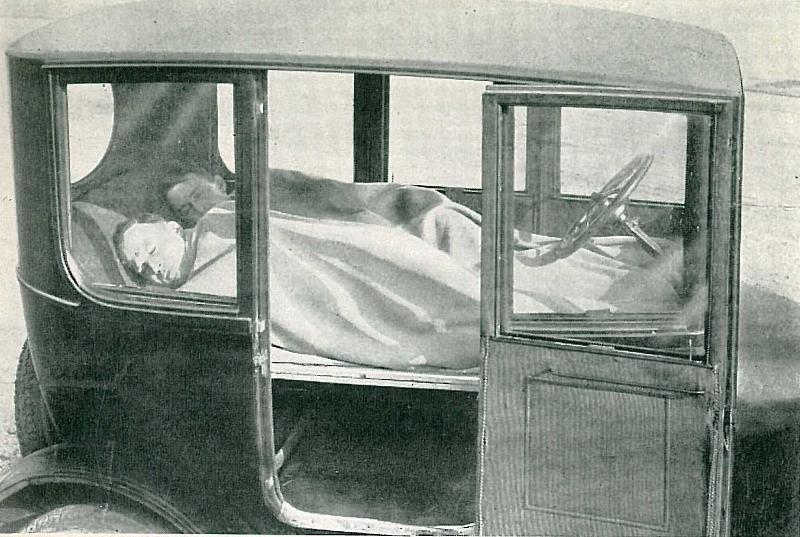
In America, July has a reputation for being the busiest month for traveling. However, in the early 1900s recreational trips were for the privileged few who could afford them. With the introduction of the mass produced Ford Model T, automobiles were more attainable than ever for the average consumer. As the number of cars on the road expanded, so too did the number of people utilizing them in their camping trips.
Taken for granted today, motor camping in the early 20th century had been widely regarded as a novelty. As such, auto travelers were often referred to as "motor gypsies," named after the nomadic people known for traveling in horse-drawn caravans. Later, they also came to be known as "tin can tourists."
However, it wasn't until the 1920s before vacationing by car really took off. Widely publicized trips of the rich and famous created a growing interest in motor camping. In his book, RVs & Campers: 1900-2000, Donald F. Wood references excursions undertaken by Thomas Edison, Harvey Firestone and Henry Ford as being the most influential. Between 1915 and 1924, they made a point to travel together almost every year, with their first trip taking them along the California coast.
From a practical standpoint, motor camping possessed economic advantages, something manufacturers of camping equipment continually emphasized in their advertisements. Being able to travel and sleep in one's car meant pricey hotel bills and rail ticket fees were a thing of the past. According to the 1926 edition of Motor Camping, a family of five adults reportedly spent only $101.03 ($66.76 for food, $34.27 for gas & oil) on a thirty-one day trip from Minnesota to Missouri. After factoring in potential costs of hotel bills, meals and rail tickets they saved an estimated $820.90 ($10,349.39 in today's currency).
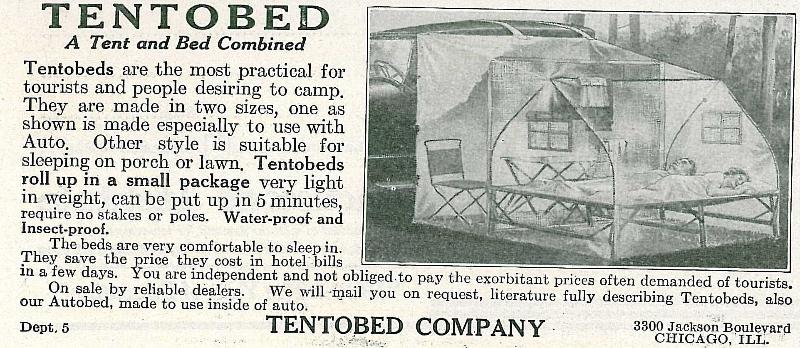
Motor homes were the most comfortable option, as well as the most expensive. In 1917, the Wiedman Body Company of New York offered a completely equipped (kitchen, shower/bath, furniture, etc.) "house car" body on a Ford TT 1 ton chassis for the steep price of $1,830. While most early camper bodies were designed by coachbuilders and crafted from wood, it wasn't unheard of for an individual to custom build their own. In the latter case, one could either build off of a commercial chassis or modify a used car. Some people, like breakfast cereal mogul W.K. Kellog even went so far as to have buses converted into traveling homes, every bit the forerunners of today's RVs.
The vast majority of early motor tourists used tents, stashing their gear on the running boards. In addition to freestanding units, lean-to tents converted one's automobile into a moveable living space with the car itself serving as a mobile dressing room. As their name would suggest, these tents attached to the roof of the car and were draped over the side.
Lean-to tents ranged in variety from simple stand-alone models to more complex pieces like the Tentobed, made by the Tentobed Company of Chicago, Illinois. One Tentobed advertisement from 1920 depicted a tent with a foldout cot, table, clothesline and screen windows complete with rollup window shades. Some tents, such as the Stoll Auto Bed, extended from both sides of the car. With a spring mattress bed big enough for two, a 1919 ad claimed it gave "Camp Comfort Supreme."
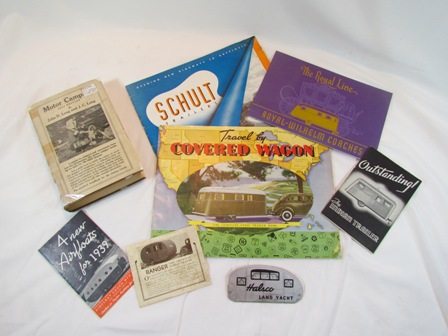
For those who disliked tents, one could turn their automobile into a self-contained bedroom by purchasing an auto bed, such as the Outers Equipment Company's 1922 Folding Ford Bed. "Ready for use in 4 minutes," setup was a breeze; the mattress was mounted over the seats and held in place with supporting rods. For protecting touring cars in wet weather, some auto bed accessories came equipped with tarpaulins.
Once the Great Depression hit in 1929 images of "Hoovervilles," impoverished shantytowns, all but killed the appeal of camping in tents. While early trailers usually featured collapsible tents, fully enclosed trailers known as "motor bungalows," made their first appearance in the 20s and rose in popularity within the next decade. By 1936, there were more than eight hundred American trailer manufacturers, a dramatic jump from 1932 considering there were less than forty.
For those interested in learning more about the history of motor camping, a visit to the Library is worthwhile. In addition to our collection of reference books devoted to the subject, our flat files contain sales literature on auto beds, tents and fifty-one different trailer manufacturers, highlighting models from 1915 to as recent as 1994. As these pieces illustrate, we have an ever-growing and diverse collection of materials thanks to generous donations from folks such as you!
Our eBay and AbeBooks Stores:
We are continually adding factory photographs to our eBay store. eBay store link here. Only a small sampling of photographs are in our eBay store, so be sure to check out the complete list of photographs we have online. Master list of photos here. In addition to eBay, all of our photographs can be purchased by email or phone.
We also have a small assortment of books and fantastic AACA memorabilia in our eBay Store. In addition, we have several books for sale on abeBooks, including a number of rare pieces. If you're looking for the perfect gift for an antique auto enthusiast, we just might have something for you.
More info available on our website. Visit AACA Library or
contact our head librarian, Chris Ritter, critter@aaca.org or 717-534-2082.
|
|
Trivia | |

1. This automobile manufacturer consistently made advancements and stayed at the forefront of front-wheel drive technology in the 1930s until, like many other companies during that era, it fell victim to the Depression.
2. What was the first passenger car with an all-independent suspension system?
3. Disc brakes were used in an English automobile as early as 1902. What was the car?
|
| AACA Museum | |
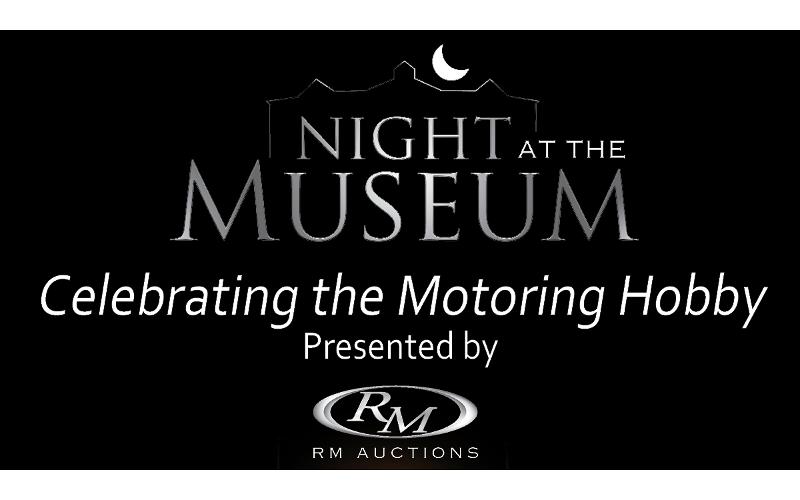
October 10, 2012 - Save the Date!
Celebrate with other enthusiasts for a fun filled night of friends and fellowship at the AACA Museum as we jump start another great meet week in Hershey!
This year's event will again be casual. Stroll through the museum with your friends as you enjoy an extensive selection of car themed comfort foods and cocktails scattered throughout all levels of the Museum. Other aspects of the evening will include live entertainment, a silent auction of unique items along with the Museum's current featured exhibits "100 Years of Chevrolet" and "Dusty Jewels: Off Road Motorcycles of the 1970s"!
So, spend a relaxed evening at the Museum mingling with old friends and new. Availability is limited, advance reservations are required at $125.00 per person and are available by calling Courtney at 717-566-7100 ext. 101 or via the website at www.NightAtTheMuseum.org. Remember this event benefits the entire AACA Family!
|
|
Trivia Answers | |
1. This automobile manufacturer consistently made advancements and stayed at the forefront of front-wheel drive technology in the 1930s until, like many other companies during that era, it fell victim to the Depression. Cord brought front-wheel drive to passenger cars in 1929, the Model L-29; it went out of business in 1937. The 1936 Model 810 is the most famous front-wheel drive Cord, its front-end design one of the most unique in automotive history.
2. What was the first passenger car with an all-independent suspension system? The Mercedes Benz 170 in the early 30s had the first all-independent suspension. The 1922 Lancia featured front-wheel independent suspension.
3. Disc brakes were used in an English automobile as early as 1902. What was the car? The Lanchester
|
|
Speedy's Notes
| |
New Website Features
We recently updated the website! Same url www.aaca.org but New and Improved features including now being able to view a past issue of Antique Automobile online ! Enjoy!
AACA Credit Card!
Members can now apply to receive an AACA Visa Card!
- No annual fee.
- $50 donation by the bank when you first use your card.
- Ongoing contributions made when you continue using the card.
- Low introductory APR on purchases and no balance transfer fees for 6 months.
- Enhance Visa Platinum benefits, including 24/7 Emergency Customer Service.
- Earn points at hundreds of participating online retailers.
- Choose one of the four created cards or upload your own vehicle.
- Show off your very own car on the front of card.
Visit the website to apply and learn more about the AACA Credit Card.
|
|
| |
AACA Official Custom Car Signs
The only approved AACA Car Show sign! Promote AACA while letting everyone know more about your car.
You fill in the blank portion of the sign (as seen below in the center photo). Sign can be staked in the grass or put your fire extinguisher on the lip. Size is approx. 16.5 high by 12 wide.
*Intended to be used for AACA National Meets.

To order, send your text exactly how you want it to appear on the sign in a Word document to abruno@aaca.org or for information call Adriana Bruno at AACA headquarters 717-534-1910
Cost is $25.00 plus shipping.
|
| |
AACA Merchandise and Gifts
New items are on the way! We have lots of unique merchandise and gift ideas available on our online catalog. Plenty to choose from for the whole family and friends. Visit the merchandise website and start shopping!
Join in the discussions and check out our topics on the AACA Forum
SPEEDSTER Archives

Read and print newsletters. Visit the links provided in each section for more information. Use the articles in your region publications and updates. Join our mailing list and please share issues with family, friends and future AACA members! SPEEDSTER Archives Here.
Judges Newsletter
|
| Calendar Spotlight! | |
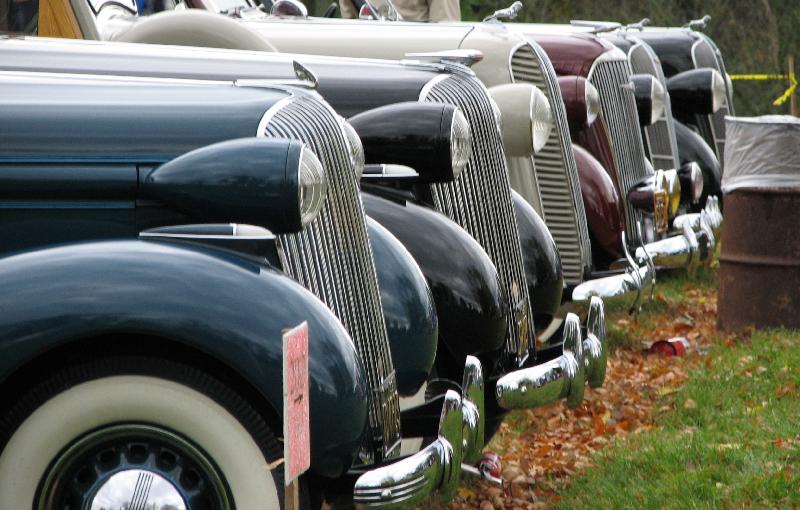
August 1-5, 2012 AACA Central Division Tour hosted by the Nebraska Region.
August 13-17, 2012 Founders Tour
August 27-31, 2012 Reliability Tour
September 13-15, 2012 Central Fall Meet in Canyon, Texas
October 10-13, 2012 Eastern Fall Meet in Hershey, PA
|
|
|
|
 |
The Antique Automobile Club of America (AACA), a 501(c)(3) nonprofit corporation, is the country's premier resource for the collectible vehicle community. Since its formation in 1935, the Club, through its national office, publications, and membership, aids individuals, museums, libraries, historians and collectors dedicated to the enjoyment and preservation of automotive history.
Contact Information for Speedster Newsletter:
AACA Headquarters
501 W. Governor Road
Hershey, PA 17033
Phone: 717-534-1910
| |
|
|
|